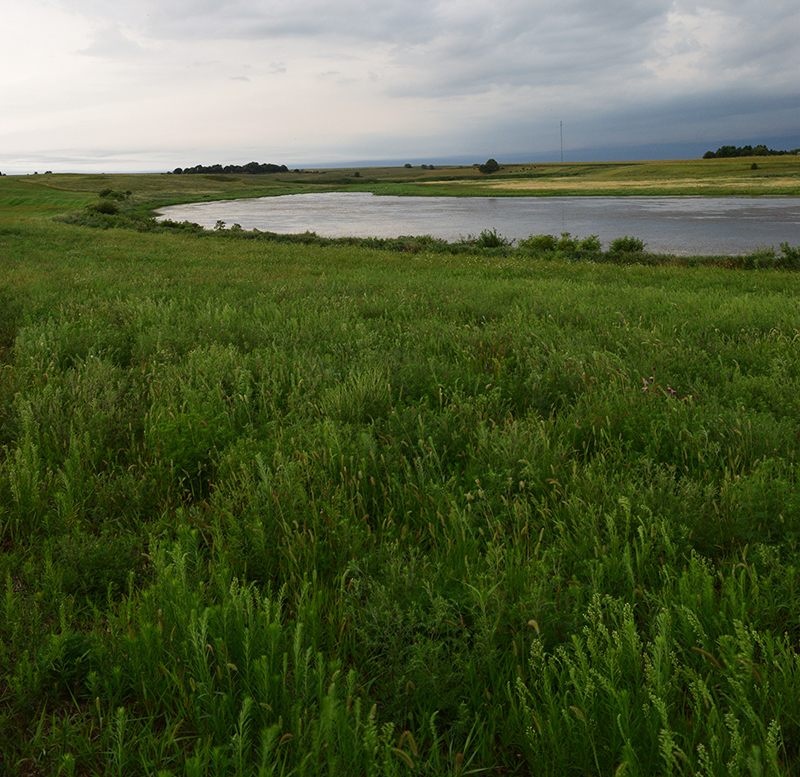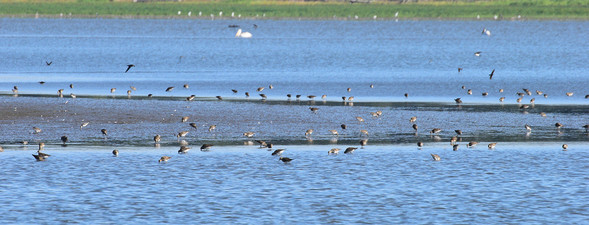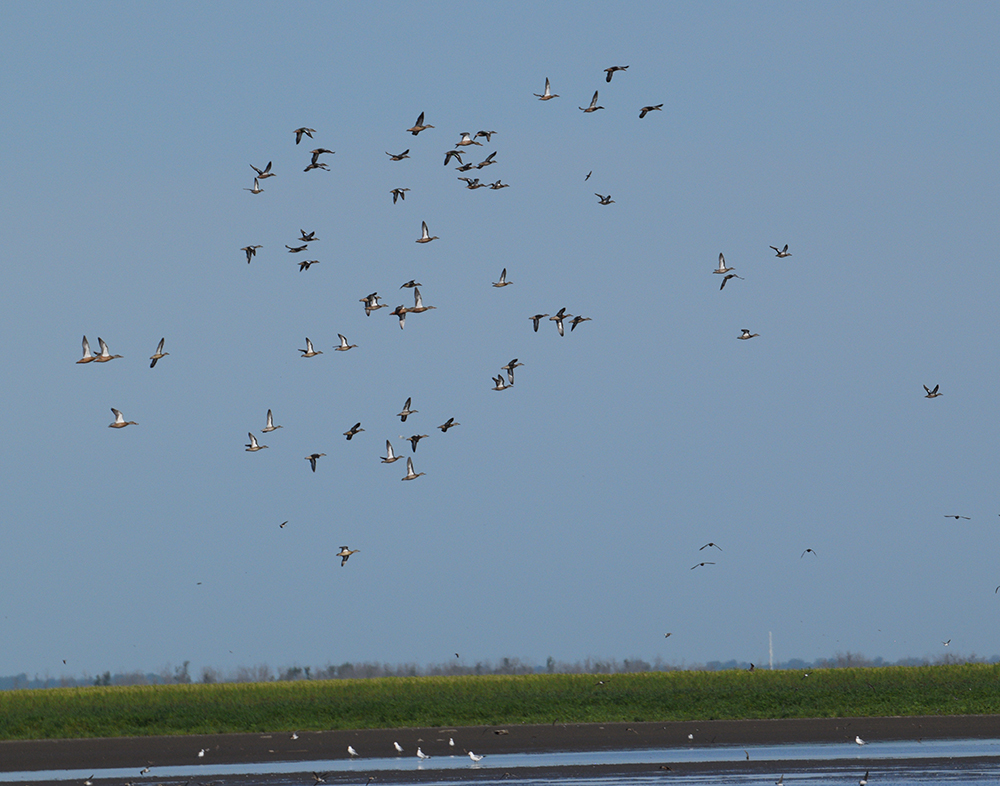|
FOR IMMEDIATE RELEASE
Aug. 25, 2020
 Since we won't see you at the Iowa State Fair this year, we're bringing the popular "state fair" magazine special to your door!
Subscribe to Iowa Outdoors magazine to get four big issues filled with beautiful photography, wildlife articles, outdoor destinations, and next year's calendar. You'll get the state fair t-shirt, in light-blue 100-percent preshrunk cotton, promoting the 100th anniversary of state parks.
To subscribe, visit the Iowa Outdoors magazine special page, or purchase through the DNR's online license site.
When subscribing, choose your t-shirt size (XXXL cost extra), and you can purchase an additional t-shirt when you order. T-shirts will be mailed by Sept. 30, 2020. The $20 price includes a one-year subscription, t-shirt and shipping costs.
Hurry! This offer is only available through August 31, 2020. We hope you enjoy Iowa Outdoors!
 Kiowa Marsh Wildlife Area is becoming a popular stopover for waterfowl and shorebirds during the spring and fall migration and its maturing prairie is attracting pheasant hunters from around Iowa and as far away as the East Coast. Photo courtesy of the Iowa DNR.
Rich Feilmeier traces his family connection to Kiowa Marsh back to before WWII when his father purchased the land to farm and have a small cow calf operation. As a kid, he recalls hunting ducks and geese off the pond where they watered their cattle.
“We shot over 100 geese one fall,” he said.
After earning his Master’s degree, Feilmeier moved back to the farmhouse where he grew up to raise his family. Since then, he’s had a front row seat to see Kiowa Marsh Wildlife Area become a 1,080-acre high quality tall and short grass prairie and wetland complex and important refueling stop for migrating waterfowl and shorebirds.
“It’s really been a nice transformation,” he said.
That transformation continues today with a 40-acre section that was converted to native prairie two years ago and is now starting to express itself.
Jeff Feisel, wildlife technician with the Iowa Department of Natural Resources (DNR), handles much of the field work for Kiowa Marsh and has noticed plant species show up that were not part of the prairie seed mix.
“I found an old typed list of prairie species from the area and started checking off the one’s I found,” he said. “I’ve found well over 40 species of plants including some that are not included on the list which means they could have been here before the prairie was plowed.”
Some of the more unique prairie species he’s found are scaly blazing star, downy gentian, rough blazing star, prairie blazing star, redroot, flowering spurge and prairie rose. The prairie has been home to state threatened northern harriers and near the wetlands, to Blandings turtles. Nearby Buena Vista University is monitoring the marshes for the reclusive turtle, last confirmed here in 2014.
Feisel said two of the existing wetlands were modified to allow for more water level manipulation – hold more water or remove water – and another large wetland will have a channel cleaned out to allow water to drain more completely to promote vegetation growth. Four new basins were added recently. One new basin on the west side is holding water for the first time since it was built and arrowhead appeared.
“The wetlands have been a big waterfowl stopover, especially in the spring,” he said. “You name it, and we’ve had that waterfowl species come through.”
It’s also attracted the shorebird migration and the bird watchers from spring through late summer. Its home to two to three pairs of trumpeter swans.
“Kiowa Marsh is often passed by for the larger areas like Dewey’s Pasture or Spring Run, but the area has a diverse prairie, with a high number of prairie flowers, lots of wetlands and I think the birders and kayakers would have a great time out here,” Feisel said.
Nonresident pheasant hunters have keyed in on Kiowa Marsh as a pheasant hunting hot spot.
“A good number of pheasant hunters come from the East Coast,” Feisel said. “It doesn’t get the pheasant hunting pressure that other areas get, but the quality of pheasant hunting here is outstanding.”
Unwanted invaders
The DNR is battling a number of invasive plant species here including unwanted shrubs buckthorn, honeysuckle and autumn olive, and plants crown vetch, sericea lespedeza and birdsfoot trefoil.
Feisel said they’re cutting and treating the brush to prevent new shoots from emerging and using spot treatments as well as broader use of chemical treatment with fire and possible grazing on the grass areas to battle the plants. “We will do a test using grazing on the waterfowl production area to try to stimulate native plants coming back with the disturbance,” he said.
Etcetera
- The first 40-acre parcel of Kiowa Marsh was acquired in 1968. The first acquisition from the Feilmeiers was in 1982, after Rich’s father passed away. A 40-acre waterfowl production area parcel to the south is the only noncontiguous piece on the area.
- Kiowa Marsh has some remnant prairie along the railroad line. From late August to early September the railroad hillside will be alive with rough blazing star.
- Kestrels have nested in a nesting box attached to an old power pole along the railroad line.
- There’s a good muskrat population in the south marsh and Feisel is hoping muskrats get established in the north wetland to help with the cattails.
- The Iowa DNR has partnered with the Iowa Natural Heritage Foundation, U.S Fish and Wildlife Service, Ducks Unlimited and the Sac and Buena Vista County Pheasants Forever chapters have been important partners in expanding the area and managing the habitat. About one-third of the marsh is federal land.
Media Contact: Jeff Feisel, Wildlife Technician, Iowa Department of Natural Resources, 712-273-5569.
 Lake Red Rock is in the midst of peak shorebird migration and currently hosting various sandpipers, sanderlings and lesser yellowlegs among the hundreds of pelicans and gulls. Photo courtesy of the Iowa DNR.
Birdwatchers know that heading north out of Pleasantville on North State Street, will lead them to a dead end at Lake Red Rock, near the impoundment that holds the greatest number of shorebirds available to birdwatchers without a boat.
The more adventurous will head out on foot from the gravel parking area to hike around the impoundment looking for shorebirds migrating from their breeding grounds in the tundra to the Gulf Coast of Texas and Mexico.
Lake Red Rock was commissioned by the U.S. Army Corps of Engineers for flood control, wildlife management and for recreation and while the wildlife management component on the lake itself revolved around water level manipulation that benefited migrating waterfowl, their management approach has shifted recently.
The Iowa Department of Natural Resources (DNR) and the U.S. Army Corps of Engineers have changed their management plan to lower the water level slightly to expose mudflats which is habitat needed for shorebirds.
Mudflats are home to invertebrates and exposing more mudflats creates opportunity for food necessary for shorebirds refueling on their thousands of miles journey to their wintering homes.
Todd Gosselink, wildlife biologist for the Iowa DNR, has been on the lake to see if the habitat manipulation is getting the intended response from the shorebirds.
Using a flat bottom boat outfitted with a mud-motor, Gosselink navigated through the shallow water of the Delta heading to the flats on this middle August morning. The Delta area is about a mile upstream from the Mile Long Bridge and while it looks like it holds a lot of depth, the water rarely gets deeper than a few feet.
At each exposed mudflat there were least sandpipers, semipalmated sandpipers, lesser yellowlegs, buff-breasted sandpiper and sanderlings. On this day, Gosselink found a semipalmated plover among the killdeer, but the most common species was the pectoral sandpiper. These shorebirds were mingling with hundreds of pelicans and gulls along with around 600 bluewing teal.
“We’re at the peak of the shorebird migration right now,” Gosselink said. “This is a deliberate attempt to manage for these shorebirds at Red Rock and Saylorville. Last week, we saw a juvenile piping plover here which was an extremely rare sighting in Marion County. A few weeks ago, there were four avocets.”
Piping plover is a federally endangered species due to loss of its nesting habitat on the beaches along the Great Lakes.
As the shorebird migration winds down, the waterfowl migration will pick up and Lake Red Rock is ready with tremendous waterfowl habitat that’s in really good shape, Gosselink said.
“When Red Rock isn’t flooding we have the great potential to manage for wildlife and conservation. Wild millet is excellent duck food and this year, it's thick,” he said.
The Corps will begin raising the water level in late September.
Media Contact: Todd Gosselink, Wildlife Biologist, Iowa Department of Natural Resources, 515-238-6936.
Iowa’s sunflower and wheat fields will be popular places on Sept. 1, when thousands of hunters slip into the standing flowers and field edges in the early morning darkness for the opening day of dove hunting season.
Fast paced and fun, dove hunting can be done by nearly everyone regardless of skill level or mobility. It doesn’t require expensive equipment to participate, only clothes that blend in to the background, a bucket and plenty of shells. There’s a lot of action with a steady stream of doves coming in.
The Iowa Department of Natural Resources (DNR) includes a list of wildlife areas at www.iowadnr.gov/doves where dove plots were planted and identifies the access point nearest the plot. Hunters are strongly encouraged to scout their areas before the season opens especially in central and east central Iowa where impact from the derecho storm was the most severe.
“Scouting is important every year, but will be especially important this year,” said Todd Bogenschutz, upland wildlife research biologist with the Iowa DNR. Hunters looking for Plan B may want to focus on private land silage or hay fields, or where farmers harvested small grain fields, grazed pastures or feedlots.
“It really comes down to getting out there and looking at the area to check the condition of the dove field, then scout it a day or two ahead of the season to see if and how the doves are using it,” he said. “We’re getting lots of dove reports that indicates a good reproduction year but success will depend on how many remain here on opening day and that depends on how many cold nights we have between now and the opener.”
Dove plots are getting increasing busy on opening day and hunters are encouraged to be courteous to one another, to pick up their spent shell casings and other trash and leave the field in good condition.
All dove hunters are required to register with the Harvest Information Program (HIP). It’s free, fast and the information is used to help determine participation and harvest. Register by following the instructions at www.iowadnr.gov/doves or by calling 1-855-242-3683.
Dove season is Sept. 1-Nov. 29. Shooting hours are one half hour before sunrise to sunset. Daily bag limit is 15 (mourning or Eurasian collared) with a possession limit of 30. Hunters are reminded that their gun must be plugged to hold no more than three shells. If hunting public areas north of I-80, hunters should check to see if nontoxic shot is required.
Media Contact: Todd Bogenschutz, Upland Wildlife Research Biologist, Iowa Department of Natural Resources, 515-979-0828.
Pheasant hunters harvested nearly 284,000 roosters in Iowa during the 2019 season, which was the second highest harvest in the last decade. In 2018, hunters harvested an estimated 320,000 roosters.
“The 2019 roadside survey showed our pheasant population was 17 percent lower than in 2018, so a reduced harvest was expected. We did see a higher success rate at the end of the season which wasn’t unexpected given Iowa’s late crop harvest last fall made hunting early in the season difficult,” said Todd Bogenschutz, upland wildlife biologist for the Iowa Department of Natural Resources (DNR).
The harvest and participation estimates are based on the results of a random survey of licensed hunters following the 2019-20 hunting season.
Iowa’s quail harvest followed the same trend. Hunters harvested an estimated 20,710 quail last year. The 2019 roadside counts showed quail numbers were 36 percent lower than 2018 counts, so the lower hunter numbers and harvest, in 2019, was expected.
“The winter of 2018-19 was a tough one for quail in Iowa, with significant winter mortality. However, the winter of 2019-20 was relatively mild and Iowa should see a bump in quail numbers this fall,” Bogenschutz said.
The survey estimated hunters harvested 54,000 rabbits, nearly 89,000 squirrels and nearly 85,000 doves.
The Iowa DNR is in the process of conducting its annual survey of upland game. The August roadside survey covers more than 6,500 miles of routes driven on gravel roads at dawn on mornings with heavy dew. Hen pheasants will move their broods to the edge of the gravel road to dry off before they begin feeding, which makes them easier to count. The statewide survey takes place between Aug. 1-15.
The August roadside survey has been conducted over the same routes since 1962. In addition to pheasants and quail, the survey collects data on partridge, cottontails and jackrabbits. Results will be posted online at www.iowadnr.gov/pheasantsurvey by Sept. 10. Iowa’s pheasant season begins Oct. 31.
Media Contact: Todd Bogenschutz, Upland Wildlife Biologist, Iowa Department of Natural Resources, 515-979-0828.
The Iowa Outdoor Expo has gone virtual this year, and extended the opportunity to learn about the outdoors for the entire month of September.
Visit www.iowadnr.gov/expo starting on Sept. 1 to view several family, friendly videos and resources to expand your skills and knowledge about recreating in Iowa's Great Outdoors!
The virtual Outdoor Expo will have the same fun and informative villages as the in-person version like archery, bow fishing, camping, canoeing, fishing, kayaking, kids’ activities, outdoor cooking, shooting ports, wild animals, and more. Each village offers self-guided activities, how to videos and where to go to participate in various outdoor activities.
“We will also be offering several free virtual workshops all month long,” said Megan Wisecup, hunter education administrator for the Iowa Department of Natural Resources. “Be sure to sign your family up. You may discover a new skill or activity that you will end up enjoying for a lifetime.”
This event is co-coordinated by the Des Moines Chapter of the Izaak Walton League and the Iowa DNR.
Media Contact: Megan Wisecup, Hunter Education Administator, Iowa Department of Natural Resources, 515-238-4968.
 Iowa’s teal season is a fun way to introduce novice hunters to duck hunting because teal decoy fairly easily and often will make a few passes over the marsh providing multiple opportunities for success. The season opens Sept. 1. Photo courtesy of the Iowa DNR.
Iowa’s 16-day statewide teal-only hunting season begins September 1 and all indicators are pointing towards hunters having a good year in Iowa.
“We likely had good production on our marshes this spring. Currently wetland conditions vary across the state with many areas drier than recent years. This is not necessarily bad because teal often select shallow water and mud flats which should be abundant this year. But it is very important that hunters scout prior to hunting,” said Orrin Jones, state waterfowl biologist for the Iowa Department of Natural Resources. “Teal are an abundant species that is lightly harvested. They are a fun species to hunt because they decoy fairly easily and often will make a few passes over the marsh, which makes it a good season to bring a young or novice hunter along.”
Part of the attraction to teal hunting, in addition to more comfortable weather, is that hunters don’t need a lot of gear to have an enjoyable hunt - just a dozen or two decoys, camouflage to blend in with the background and boots or waders (or a dog) to get any downed birds.
Jones suggested hunters prepare for the season by going through their equipment and replacing any that’s worn out or broken and spend some time scouting the areas they plan to hunt.
“Scouting is an important part of waterfowl hunting. Finding shallow wetlands with vegetation is a key to success. It’s tough to predict when the birds are going to push through but hunting a wetland with water and food will improve the chances to find teal,” he said.
Because this is a teal-only hunting season, properly identifying teal is crucial.
“Set up in a place with good visibility and use the sun to your advantage either over your shoulder or at your back. Look closely to determine if it’s a teal and if you’re unsure, give them a pass – they’ll come around again,” Jones said.
The September teal season is a bonus season that does not count against the number of days available for the regular duck season. It has different shooting hours from regular duck season; shooting hours for teal season begins at sunrise and ends at sunset. Hunters are required to limit their gun to holding no more than three shells and must use nontoxic shot only. The daily bag limit is six teal with a possession limit of 18.
Hunters reminded Federal Duck Stamp available from Iowa hunting licenses vendors, GoOudoorsIowa app
Hunters are reminded they can purchase their federal duck stamp wherever they purchase their Iowa hunting and fishing licenses and on the GoOutdoorsIowa app. Hunters will receive a temporary e-stamp that is valid for 45 days. The physical stamp will arrive in the mail.
Waterfowl hunters are required to purchase an Iowa migratory game bird fee and the federal duck stamp, in addition to having a valid Iowa hunting license and habitat fee, in order to hunt waterfowl.
Media Contact: Orrin Jones, State Waterfowl Biologist, Iowa Department of Natural Resources, 641-231-1957.
The good news for Iowa’s cottontail rabbit hunters is that Iowa has a strong population of rabbits, similar to last year, with the southern and east central part of the state seeing the best overall numbers. The better news for hunters is Iowa’s cottontail rabbit season begins Sept. 5 statewide.
“It should be another great year for rabbit hunting not only for experienced hunters, but for young or novice hunters who can learn necessary skills with little competition,” said Todd Bogenschutz, upland wildlife research biologist for the Iowa Department of Natural Resources.
Last year, an estimated 15,200 hunters harvested more than 54,000 cottontail rabbits. The most popular way to hunt is with a shotgun walking brushy areas with grass next to crop fields in the morning or evening. It can be done individually or with a group of friends.
Rabbit hunting does not require a significant investment or high tech equipment, just a shotgun and some shells. Rabbit is a lean, low fat meat and popular table fare considered a delicacy in many culinary circles.
Cottontail rabbit season is Sept. 5 to Feb. 28, 2021. The daily limit is 10 rabbits with a possession limit of 20. Jackrabbit season is closed. While wearing blaze orange clothing is not required to hunt rabbits, it is recommended. Shooting hours for rabbits is sunrise to sunset.
Iowa’s cottontail rabbit population estimates are included in the recently completed August roadside survey of upland wildlife species. Results will likely be published around the first week of September at www.iowadnr.gov/pheasantsurvey.
Iowa’s squirrel population generally follows the acorn production and last year saw good production statewide, with white oak and bur oak leading the way.
Squirrel hunting is an inexpensive and exciting way to get introduced into hunting. Those new to hunting can gain valuable woodsmanship skills as squirrels will twist and turn hunters through the woodlands.
“One beauty of squirrel hunting is if you mess up and spook a squirrel there is usually another one just down the ridge, this provides lots of opportunities for success,” said Jim Coffey, forest wildlife biologist for the Iowa DNR. “Experienced hunters often say that they haven’t hunted squirrels since they were a kid. Well, this is the year to be a kid again. Get yourself outside chasing squirrels and bring someone new to hunting along. Squirrels are definitely an underutilized resource.”
Hunters will generally find plenty of squirrels and little competition. This would also be a good opportunity to do some scouting for a spring turkey hunt or to look for whitetail deer rubs before bow season.
“These honed skills will make you an overall better hunter. Many of the skills needed for squirrel hunting are also used for spring turkey hunting,” Coffey said.
Last year, nearly 16,000 squirrel hunters harvested approximately 89,000 squirrels.
Squirrel season is Sept. 5 to Jan. 31, 2021, with a daily bag limit of six total or combination of red fox squirrels or eastern grey squirrels and a possession limit of 12. Fox squirrels are generally found in more open pasture timber and woodlots whereas grey squirrels tend to be in more mature timber. aThere is no restriction on shooting hours.
Hunters looking for places to go rabbit or squirrel hunting should use Iowa’s online hunting atlas at www.iowadnr.gov/hunting, with more than 600,000 acres of public land that allows hunting.
Media Contacts: Rabbits - Todd Bogenschutz, Upland Wildlife Research Biologist, Iowa Department of Natural Resources, 515-979-0828. Squirrels – Jim Coffey, Forest Wildlife Research Biologist, Iowa Department of Natural Resources, 641-774-2958.
The Iowa Department of Natural Resources is working with state and local officials to reduce the spread of COVID-19 and has transitioned employees to work remotely. DNR offices are closed to the public during this time and only available by appointment.
In other efforts to further reduce the spread of Covid-19, the DNR is encouraging the use of the online services for purchasing licenses, submitting applications, payments and other daily tasks and interaction with DNR staff.
The FREE Go Outdoors Iowa app is available at the App store and Google Play. The Go Outdoors Iowa app allows users to purchase and view hunting and fishing licenses and submit harvest and quota reports, all from your cell phone.
Full list of DNR’s online services: https://www.iowadnr.gov/about-dnr/about-dnr/online-services-databases.
Up-to-date information on DNR services, facilities and events impacted by Covid-19: https://www.iowadnr.gov/About-DNR/Covid-19.
Technical information for regulated businesses in regards to Covid-19: https://www.iowadnr.gov/About-DNR/Social-Media-Press-Room/Disaster-Assistance#3057321-covid---19-outbreak.
Thank you for your patience and flexibility during this time. If you need to contact DNR staff you can reach them by email or phone or by calling (515) 725-8200.
|